Analysis of Nestle's Production and Operations Management Strategies
VerifiedAdded on 2022/01/19
|13
|3884
|86
Report
AI Summary
This report presents a comprehensive case study on Nestle, focusing on its production and operations management strategies. The introduction highlights the importance of efficient production processes in today's globalized world, emphasizing the need for innovative strategies to meet consumer demands and maintain product quality. The report explores key concepts such as input, output, and customer satisfaction within production and operations management. It then delves into various process strategies, including product focus, repetitive focus, process focus, and mass customization, providing detailed descriptions of each. A literature review provides an overview of Nestle, including its history, products (specifically Nestle Pure Life), and processing methods. The core of the report analyzes Nestle's chosen process strategy and presents case study findings related to production, operations, and customer satisfaction. The report concludes with a summary of the key takeaways and findings, referencing the importance of effective process strategies and customer-centric approaches in achieving business success. The report provides valuable insights into Nestle's operational excellence and strategic decision-making.
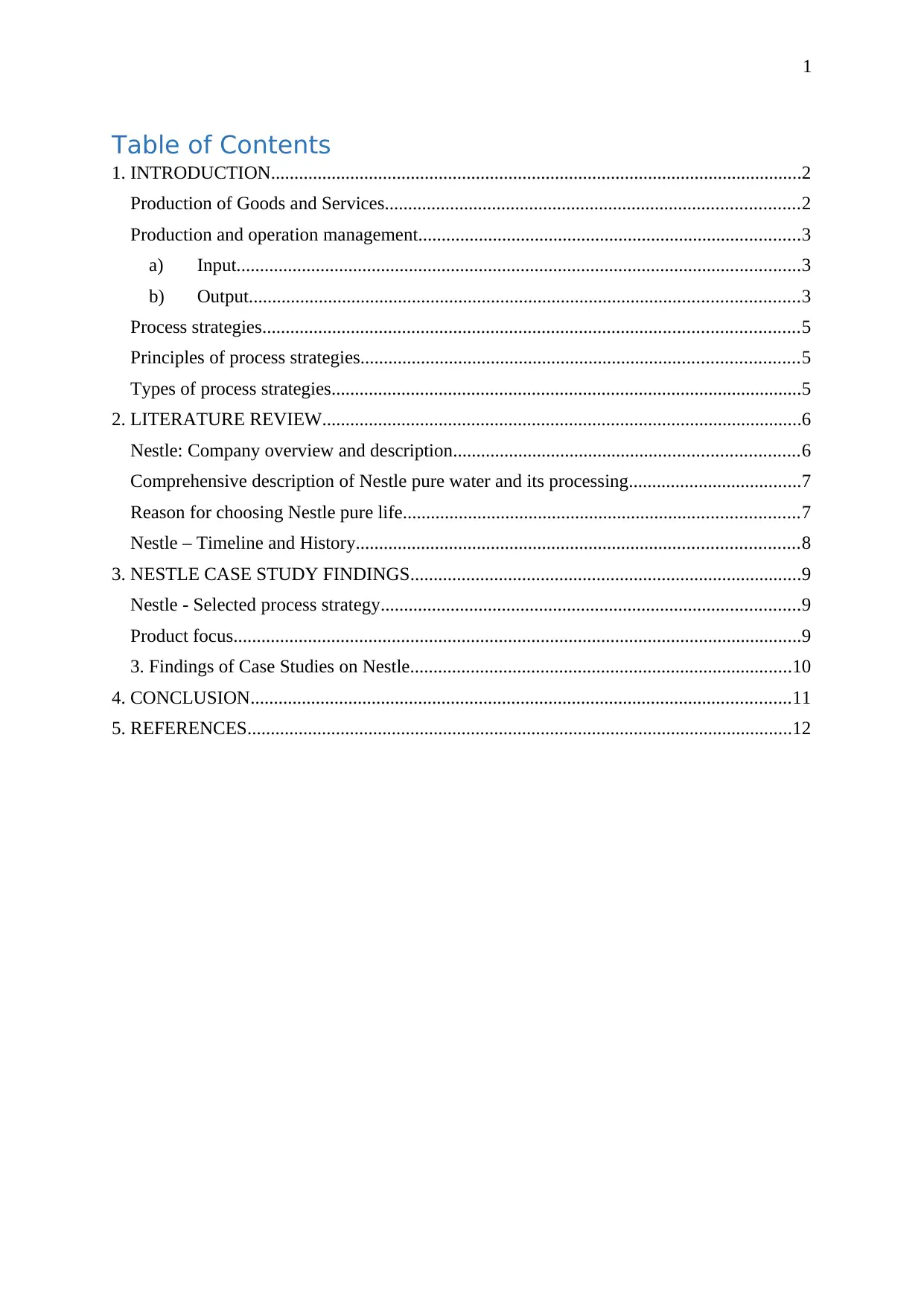
1
Table of Contents
1. INTRODUCTION..................................................................................................................2
Production of Goods and Services.........................................................................................2
Production and operation management..................................................................................3
a) Input.........................................................................................................................3
b) Output......................................................................................................................3
Process strategies...................................................................................................................5
Principles of process strategies..............................................................................................5
Types of process strategies.....................................................................................................5
2. LITERATURE REVIEW.......................................................................................................6
Nestle: Company overview and description..........................................................................6
Comprehensive description of Nestle pure water and its processing.....................................7
Reason for choosing Nestle pure life.....................................................................................7
Nestle – Timeline and History...............................................................................................8
3. NESTLE CASE STUDY FINDINGS....................................................................................9
Nestle - Selected process strategy..........................................................................................9
Product focus..........................................................................................................................9
3. Findings of Case Studies on Nestle..................................................................................10
4. CONCLUSION....................................................................................................................11
5. REFERENCES.....................................................................................................................12
Table of Contents
1. INTRODUCTION..................................................................................................................2
Production of Goods and Services.........................................................................................2
Production and operation management..................................................................................3
a) Input.........................................................................................................................3
b) Output......................................................................................................................3
Process strategies...................................................................................................................5
Principles of process strategies..............................................................................................5
Types of process strategies.....................................................................................................5
2. LITERATURE REVIEW.......................................................................................................6
Nestle: Company overview and description..........................................................................6
Comprehensive description of Nestle pure water and its processing.....................................7
Reason for choosing Nestle pure life.....................................................................................7
Nestle – Timeline and History...............................................................................................8
3. NESTLE CASE STUDY FINDINGS....................................................................................9
Nestle - Selected process strategy..........................................................................................9
Product focus..........................................................................................................................9
3. Findings of Case Studies on Nestle..................................................................................10
4. CONCLUSION....................................................................................................................11
5. REFERENCES.....................................................................................................................12
Paraphrase This Document
Need a fresh take? Get an instant paraphrase of this document with our AI Paraphraser
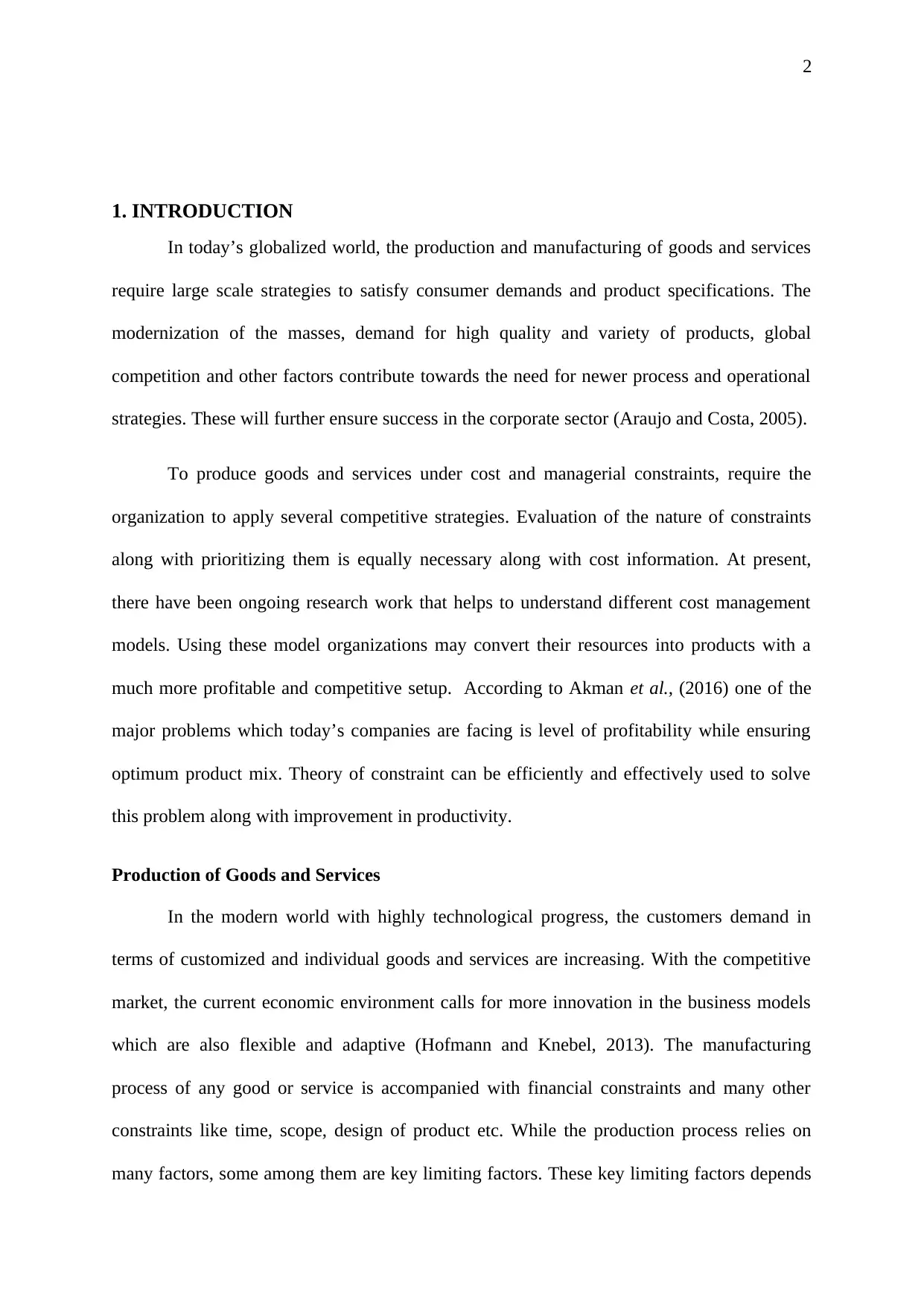
2
1. INTRODUCTION
In today’s globalized world, the production and manufacturing of goods and services
require large scale strategies to satisfy consumer demands and product specifications. The
modernization of the masses, demand for high quality and variety of products, global
competition and other factors contribute towards the need for newer process and operational
strategies. These will further ensure success in the corporate sector (Araujo and Costa, 2005).
To produce goods and services under cost and managerial constraints, require the
organization to apply several competitive strategies. Evaluation of the nature of constraints
along with prioritizing them is equally necessary along with cost information. At present,
there have been ongoing research work that helps to understand different cost management
models. Using these model organizations may convert their resources into products with a
much more profitable and competitive setup. According to Akman et al., (2016) one of the
major problems which today’s companies are facing is level of profitability while ensuring
optimum product mix. Theory of constraint can be efficiently and effectively used to solve
this problem along with improvement in productivity.
Production of Goods and Services
In the modern world with highly technological progress, the customers demand in
terms of customized and individual goods and services are increasing. With the competitive
market, the current economic environment calls for more innovation in the business models
which are also flexible and adaptive (Hofmann and Knebel, 2013). The manufacturing
process of any good or service is accompanied with financial constraints and many other
constraints like time, scope, design of product etc. While the production process relies on
many factors, some among them are key limiting factors. These key limiting factors depends
1. INTRODUCTION
In today’s globalized world, the production and manufacturing of goods and services
require large scale strategies to satisfy consumer demands and product specifications. The
modernization of the masses, demand for high quality and variety of products, global
competition and other factors contribute towards the need for newer process and operational
strategies. These will further ensure success in the corporate sector (Araujo and Costa, 2005).
To produce goods and services under cost and managerial constraints, require the
organization to apply several competitive strategies. Evaluation of the nature of constraints
along with prioritizing them is equally necessary along with cost information. At present,
there have been ongoing research work that helps to understand different cost management
models. Using these model organizations may convert their resources into products with a
much more profitable and competitive setup. According to Akman et al., (2016) one of the
major problems which today’s companies are facing is level of profitability while ensuring
optimum product mix. Theory of constraint can be efficiently and effectively used to solve
this problem along with improvement in productivity.
Production of Goods and Services
In the modern world with highly technological progress, the customers demand in
terms of customized and individual goods and services are increasing. With the competitive
market, the current economic environment calls for more innovation in the business models
which are also flexible and adaptive (Hofmann and Knebel, 2013). The manufacturing
process of any good or service is accompanied with financial constraints and many other
constraints like time, scope, design of product etc. While the production process relies on
many factors, some among them are key limiting factors. These key limiting factors depends
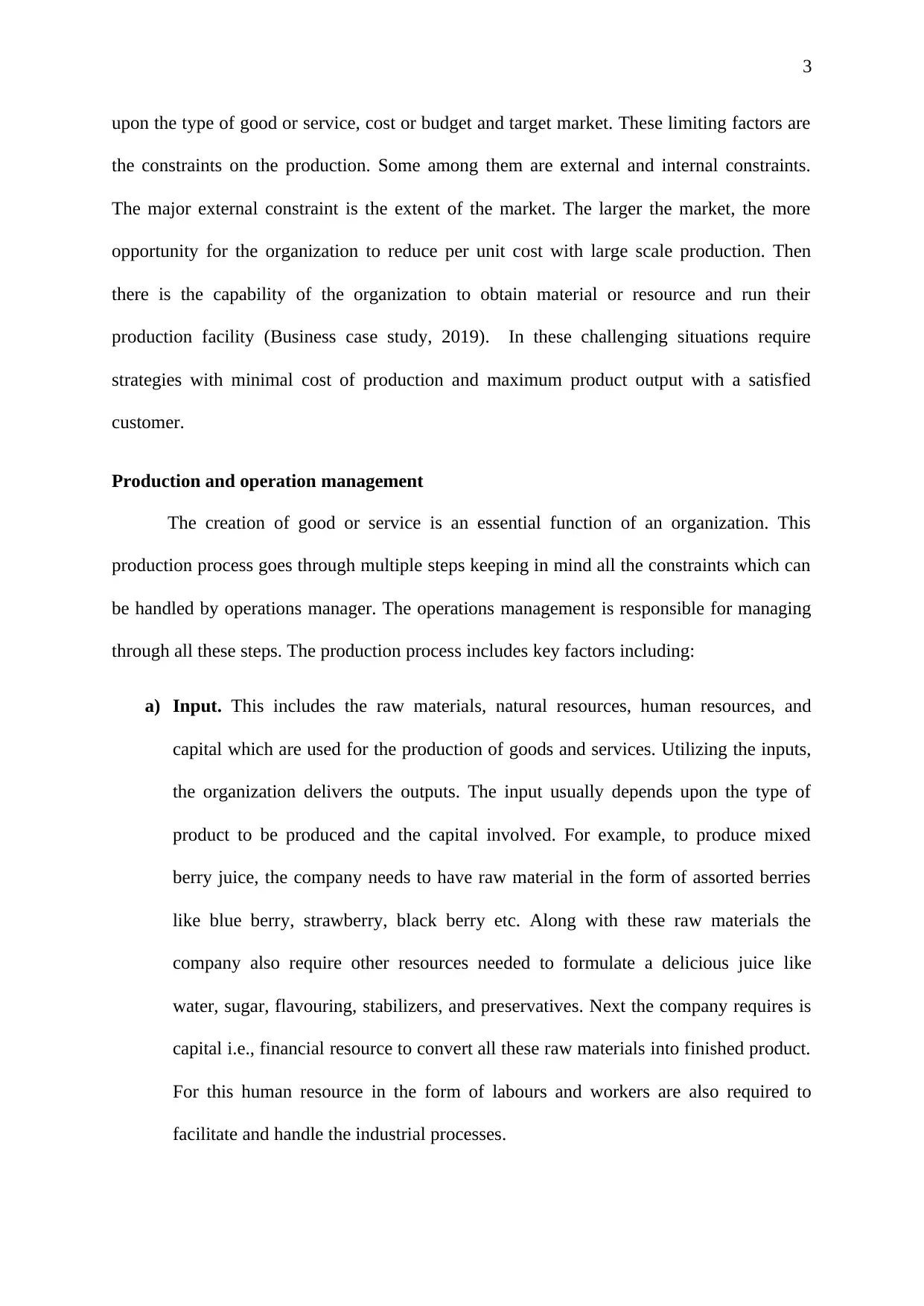
3
upon the type of good or service, cost or budget and target market. These limiting factors are
the constraints on the production. Some among them are external and internal constraints.
The major external constraint is the extent of the market. The larger the market, the more
opportunity for the organization to reduce per unit cost with large scale production. Then
there is the capability of the organization to obtain material or resource and run their
production facility (Business case study, 2019). In these challenging situations require
strategies with minimal cost of production and maximum product output with a satisfied
customer.
Production and operation management
The creation of good or service is an essential function of an organization. This
production process goes through multiple steps keeping in mind all the constraints which can
be handled by operations manager. The operations management is responsible for managing
through all these steps. The production process includes key factors including:
a) Input. This includes the raw materials, natural resources, human resources, and
capital which are used for the production of goods and services. Utilizing the inputs,
the organization delivers the outputs. The input usually depends upon the type of
product to be produced and the capital involved. For example, to produce mixed
berry juice, the company needs to have raw material in the form of assorted berries
like blue berry, strawberry, black berry etc. Along with these raw materials the
company also require other resources needed to formulate a delicious juice like
water, sugar, flavouring, stabilizers, and preservatives. Next the company requires is
capital i.e., financial resource to convert all these raw materials into finished product.
For this human resource in the form of labours and workers are also required to
facilitate and handle the industrial processes.
upon the type of good or service, cost or budget and target market. These limiting factors are
the constraints on the production. Some among them are external and internal constraints.
The major external constraint is the extent of the market. The larger the market, the more
opportunity for the organization to reduce per unit cost with large scale production. Then
there is the capability of the organization to obtain material or resource and run their
production facility (Business case study, 2019). In these challenging situations require
strategies with minimal cost of production and maximum product output with a satisfied
customer.
Production and operation management
The creation of good or service is an essential function of an organization. This
production process goes through multiple steps keeping in mind all the constraints which can
be handled by operations manager. The operations management is responsible for managing
through all these steps. The production process includes key factors including:
a) Input. This includes the raw materials, natural resources, human resources, and
capital which are used for the production of goods and services. Utilizing the inputs,
the organization delivers the outputs. The input usually depends upon the type of
product to be produced and the capital involved. For example, to produce mixed
berry juice, the company needs to have raw material in the form of assorted berries
like blue berry, strawberry, black berry etc. Along with these raw materials the
company also require other resources needed to formulate a delicious juice like
water, sugar, flavouring, stabilizers, and preservatives. Next the company requires is
capital i.e., financial resource to convert all these raw materials into finished product.
For this human resource in the form of labours and workers are also required to
facilitate and handle the industrial processes.
⊘ This is a preview!⊘
Do you want full access?
Subscribe today to unlock all pages.

Trusted by 1+ million students worldwide
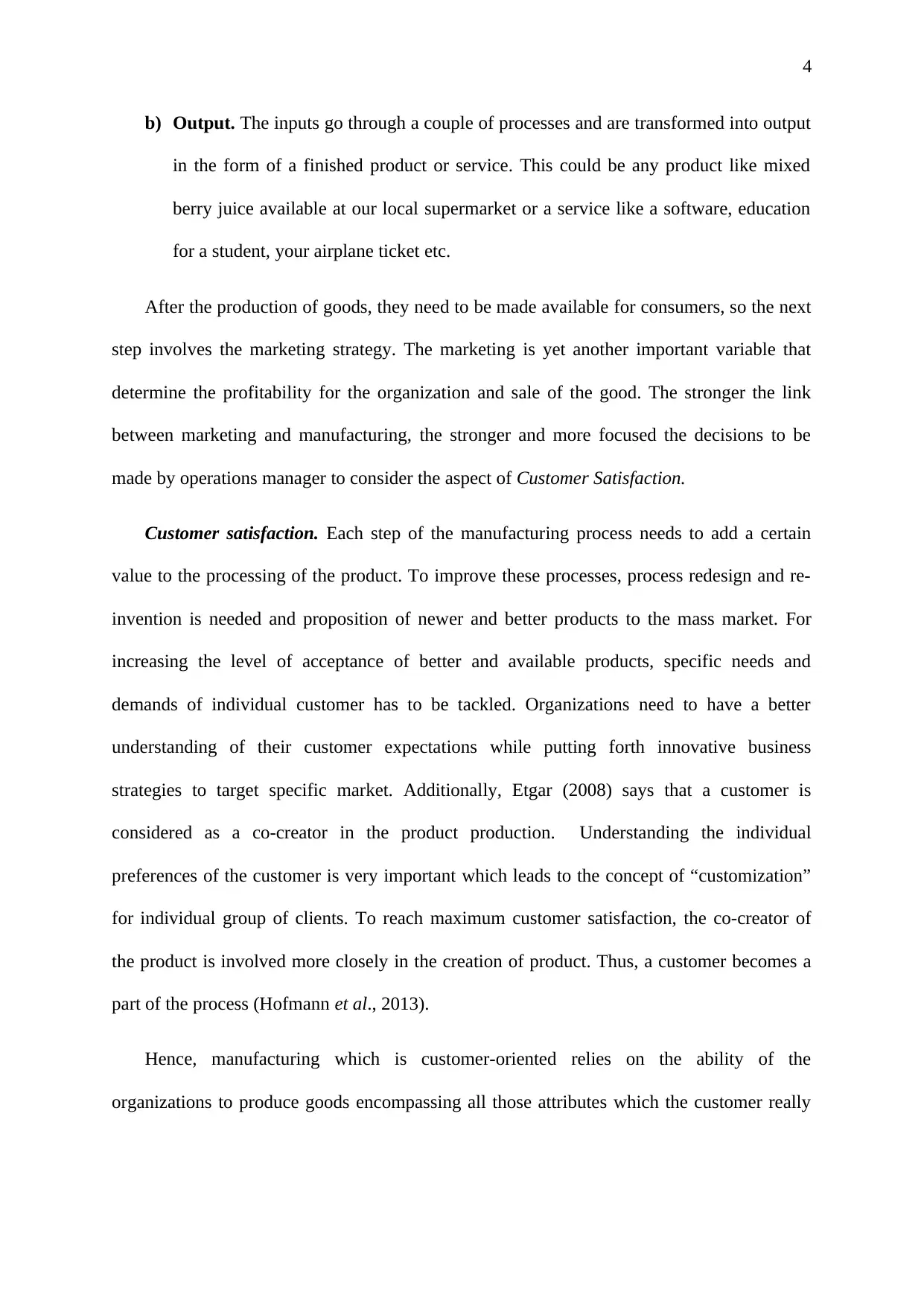
4
b) Output. The inputs go through a couple of processes and are transformed into output
in the form of a finished product or service. This could be any product like mixed
berry juice available at our local supermarket or a service like a software, education
for a student, your airplane ticket etc.
After the production of goods, they need to be made available for consumers, so the next
step involves the marketing strategy. The marketing is yet another important variable that
determine the profitability for the organization and sale of the good. The stronger the link
between marketing and manufacturing, the stronger and more focused the decisions to be
made by operations manager to consider the aspect of Customer Satisfaction.
Customer satisfaction. Each step of the manufacturing process needs to add a certain
value to the processing of the product. To improve these processes, process redesign and re-
invention is needed and proposition of newer and better products to the mass market. For
increasing the level of acceptance of better and available products, specific needs and
demands of individual customer has to be tackled. Organizations need to have a better
understanding of their customer expectations while putting forth innovative business
strategies to target specific market. Additionally, Etgar (2008) says that a customer is
considered as a co-creator in the product production. Understanding the individual
preferences of the customer is very important which leads to the concept of “customization”
for individual group of clients. To reach maximum customer satisfaction, the co-creator of
the product is involved more closely in the creation of product. Thus, a customer becomes a
part of the process (Hofmann et al., 2013).
Hence, manufacturing which is customer-oriented relies on the ability of the
organizations to produce goods encompassing all those attributes which the customer really
b) Output. The inputs go through a couple of processes and are transformed into output
in the form of a finished product or service. This could be any product like mixed
berry juice available at our local supermarket or a service like a software, education
for a student, your airplane ticket etc.
After the production of goods, they need to be made available for consumers, so the next
step involves the marketing strategy. The marketing is yet another important variable that
determine the profitability for the organization and sale of the good. The stronger the link
between marketing and manufacturing, the stronger and more focused the decisions to be
made by operations manager to consider the aspect of Customer Satisfaction.
Customer satisfaction. Each step of the manufacturing process needs to add a certain
value to the processing of the product. To improve these processes, process redesign and re-
invention is needed and proposition of newer and better products to the mass market. For
increasing the level of acceptance of better and available products, specific needs and
demands of individual customer has to be tackled. Organizations need to have a better
understanding of their customer expectations while putting forth innovative business
strategies to target specific market. Additionally, Etgar (2008) says that a customer is
considered as a co-creator in the product production. Understanding the individual
preferences of the customer is very important which leads to the concept of “customization”
for individual group of clients. To reach maximum customer satisfaction, the co-creator of
the product is involved more closely in the creation of product. Thus, a customer becomes a
part of the process (Hofmann et al., 2013).
Hence, manufacturing which is customer-oriented relies on the ability of the
organizations to produce goods encompassing all those attributes which the customer really
Paraphrase This Document
Need a fresh take? Get an instant paraphrase of this document with our AI Paraphraser
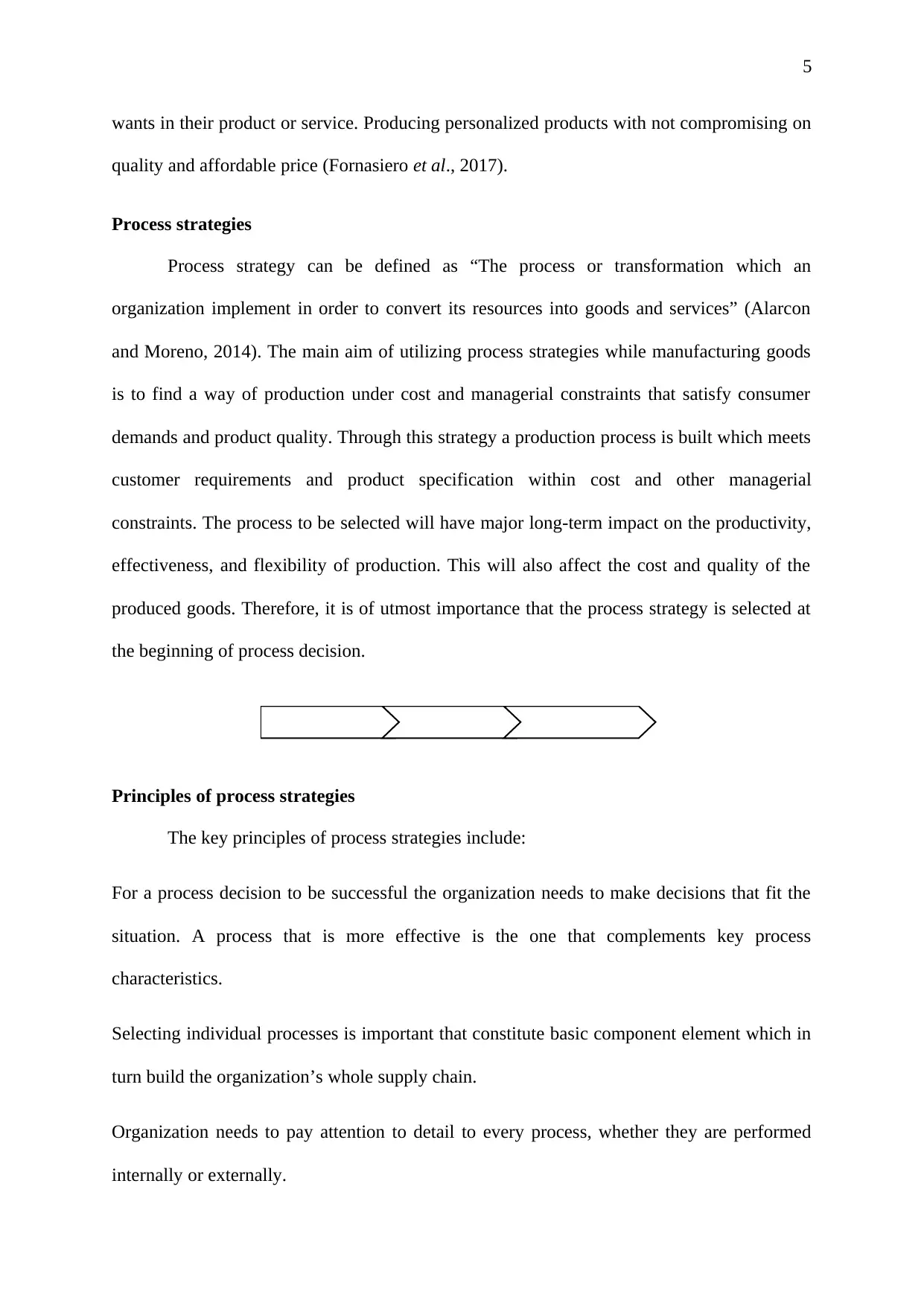
5
wants in their product or service. Producing personalized products with not compromising on
quality and affordable price (Fornasiero et al., 2017).
Process strategies
Process strategy can be defined as “The process or transformation which an
organization implement in order to convert its resources into goods and services” (Alarcon
and Moreno, 2014). The main aim of utilizing process strategies while manufacturing goods
is to find a way of production under cost and managerial constraints that satisfy consumer
demands and product quality. Through this strategy a production process is built which meets
customer requirements and product specification within cost and other managerial
constraints. The process to be selected will have major long-term impact on the productivity,
effectiveness, and flexibility of production. This will also affect the cost and quality of the
produced goods. Therefore, it is of utmost importance that the process strategy is selected at
the beginning of process decision.
Principles of process strategies
The key principles of process strategies include:
For a process decision to be successful the organization needs to make decisions that fit the
situation. A process that is more effective is the one that complements key process
characteristics.
Selecting individual processes is important that constitute basic component element which in
turn build the organization’s whole supply chain.
Organization needs to pay attention to detail to every process, whether they are performed
internally or externally.
Input Production Output
wants in their product or service. Producing personalized products with not compromising on
quality and affordable price (Fornasiero et al., 2017).
Process strategies
Process strategy can be defined as “The process or transformation which an
organization implement in order to convert its resources into goods and services” (Alarcon
and Moreno, 2014). The main aim of utilizing process strategies while manufacturing goods
is to find a way of production under cost and managerial constraints that satisfy consumer
demands and product quality. Through this strategy a production process is built which meets
customer requirements and product specification within cost and other managerial
constraints. The process to be selected will have major long-term impact on the productivity,
effectiveness, and flexibility of production. This will also affect the cost and quality of the
produced goods. Therefore, it is of utmost importance that the process strategy is selected at
the beginning of process decision.
Principles of process strategies
The key principles of process strategies include:
For a process decision to be successful the organization needs to make decisions that fit the
situation. A process that is more effective is the one that complements key process
characteristics.
Selecting individual processes is important that constitute basic component element which in
turn build the organization’s whole supply chain.
Organization needs to pay attention to detail to every process, whether they are performed
internally or externally.
Input Production Output
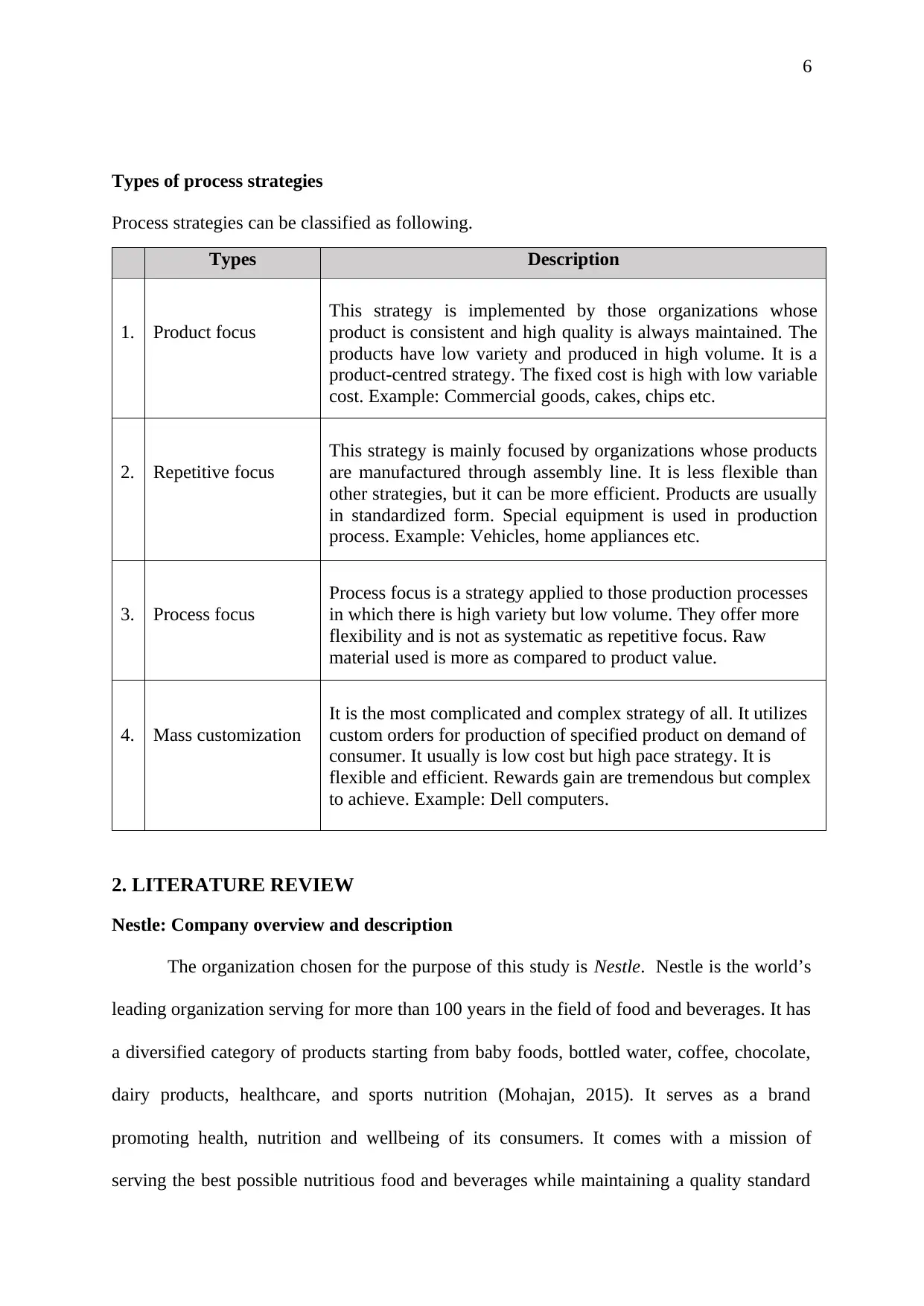
6
Types of process strategies
Process strategies can be classified as following.
Types Description
1. Product focus
This strategy is implemented by those organizations whose
product is consistent and high quality is always maintained. The
products have low variety and produced in high volume. It is a
product-centred strategy. The fixed cost is high with low variable
cost. Example: Commercial goods, cakes, chips etc.
2. Repetitive focus
This strategy is mainly focused by organizations whose products
are manufactured through assembly line. It is less flexible than
other strategies, but it can be more efficient. Products are usually
in standardized form. Special equipment is used in production
process. Example: Vehicles, home appliances etc.
3. Process focus
Process focus is a strategy applied to those production processes
in which there is high variety but low volume. They offer more
flexibility and is not as systematic as repetitive focus. Raw
material used is more as compared to product value.
4. Mass customization
It is the most complicated and complex strategy of all. It utilizes
custom orders for production of specified product on demand of
consumer. It usually is low cost but high pace strategy. It is
flexible and efficient. Rewards gain are tremendous but complex
to achieve. Example: Dell computers.
2. LITERATURE REVIEW
Nestle: Company overview and description
The organization chosen for the purpose of this study is Nestle. Nestle is the world’s
leading organization serving for more than 100 years in the field of food and beverages. It has
a diversified category of products starting from baby foods, bottled water, coffee, chocolate,
dairy products, healthcare, and sports nutrition (Mohajan, 2015). It serves as a brand
promoting health, nutrition and wellbeing of its consumers. It comes with a mission of
serving the best possible nutritious food and beverages while maintaining a quality standard
Types of process strategies
Process strategies can be classified as following.
Types Description
1. Product focus
This strategy is implemented by those organizations whose
product is consistent and high quality is always maintained. The
products have low variety and produced in high volume. It is a
product-centred strategy. The fixed cost is high with low variable
cost. Example: Commercial goods, cakes, chips etc.
2. Repetitive focus
This strategy is mainly focused by organizations whose products
are manufactured through assembly line. It is less flexible than
other strategies, but it can be more efficient. Products are usually
in standardized form. Special equipment is used in production
process. Example: Vehicles, home appliances etc.
3. Process focus
Process focus is a strategy applied to those production processes
in which there is high variety but low volume. They offer more
flexibility and is not as systematic as repetitive focus. Raw
material used is more as compared to product value.
4. Mass customization
It is the most complicated and complex strategy of all. It utilizes
custom orders for production of specified product on demand of
consumer. It usually is low cost but high pace strategy. It is
flexible and efficient. Rewards gain are tremendous but complex
to achieve. Example: Dell computers.
2. LITERATURE REVIEW
Nestle: Company overview and description
The organization chosen for the purpose of this study is Nestle. Nestle is the world’s
leading organization serving for more than 100 years in the field of food and beverages. It has
a diversified category of products starting from baby foods, bottled water, coffee, chocolate,
dairy products, healthcare, and sports nutrition (Mohajan, 2015). It serves as a brand
promoting health, nutrition and wellbeing of its consumers. It comes with a mission of
serving the best possible nutritious food and beverages while maintaining a quality standard
⊘ This is a preview!⊘
Do you want full access?
Subscribe today to unlock all pages.

Trusted by 1+ million students worldwide
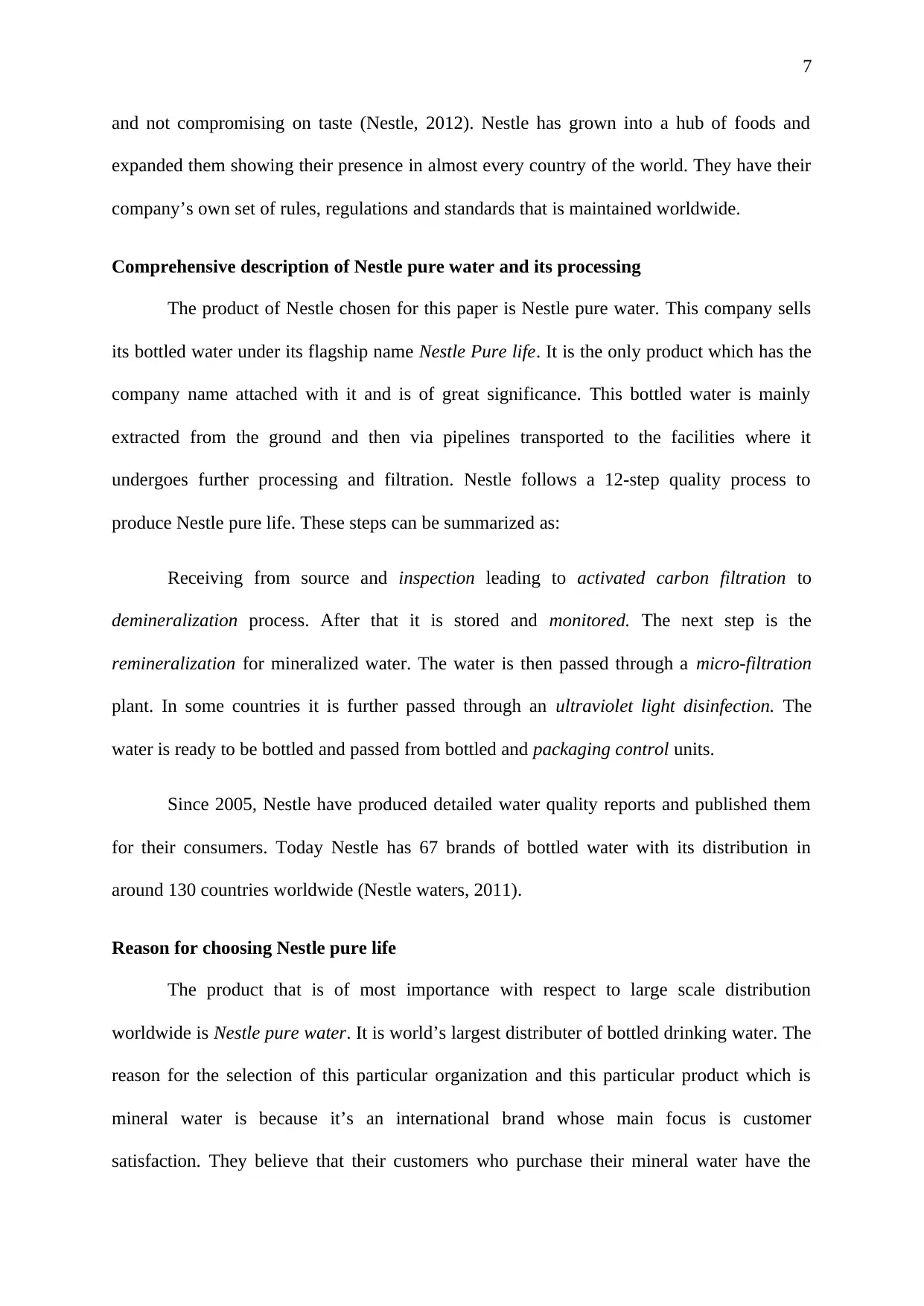
7
and not compromising on taste (Nestle, 2012). Nestle has grown into a hub of foods and
expanded them showing their presence in almost every country of the world. They have their
company’s own set of rules, regulations and standards that is maintained worldwide.
Comprehensive description of Nestle pure water and its processing
The product of Nestle chosen for this paper is Nestle pure water. This company sells
its bottled water under its flagship name Nestle Pure life. It is the only product which has the
company name attached with it and is of great significance. This bottled water is mainly
extracted from the ground and then via pipelines transported to the facilities where it
undergoes further processing and filtration. Nestle follows a 12-step quality process to
produce Nestle pure life. These steps can be summarized as:
Receiving from source and inspection leading to activated carbon filtration to
demineralization process. After that it is stored and monitored. The next step is the
remineralization for mineralized water. The water is then passed through a micro-filtration
plant. In some countries it is further passed through an ultraviolet light disinfection. The
water is ready to be bottled and passed from bottled and packaging control units.
Since 2005, Nestle have produced detailed water quality reports and published them
for their consumers. Today Nestle has 67 brands of bottled water with its distribution in
around 130 countries worldwide (Nestle waters, 2011).
Reason for choosing Nestle pure life
The product that is of most importance with respect to large scale distribution
worldwide is Nestle pure water. It is world’s largest distributer of bottled drinking water. The
reason for the selection of this particular organization and this particular product which is
mineral water is because it’s an international brand whose main focus is customer
satisfaction. They believe that their customers who purchase their mineral water have the
and not compromising on taste (Nestle, 2012). Nestle has grown into a hub of foods and
expanded them showing their presence in almost every country of the world. They have their
company’s own set of rules, regulations and standards that is maintained worldwide.
Comprehensive description of Nestle pure water and its processing
The product of Nestle chosen for this paper is Nestle pure water. This company sells
its bottled water under its flagship name Nestle Pure life. It is the only product which has the
company name attached with it and is of great significance. This bottled water is mainly
extracted from the ground and then via pipelines transported to the facilities where it
undergoes further processing and filtration. Nestle follows a 12-step quality process to
produce Nestle pure life. These steps can be summarized as:
Receiving from source and inspection leading to activated carbon filtration to
demineralization process. After that it is stored and monitored. The next step is the
remineralization for mineralized water. The water is then passed through a micro-filtration
plant. In some countries it is further passed through an ultraviolet light disinfection. The
water is ready to be bottled and passed from bottled and packaging control units.
Since 2005, Nestle have produced detailed water quality reports and published them
for their consumers. Today Nestle has 67 brands of bottled water with its distribution in
around 130 countries worldwide (Nestle waters, 2011).
Reason for choosing Nestle pure life
The product that is of most importance with respect to large scale distribution
worldwide is Nestle pure water. It is world’s largest distributer of bottled drinking water. The
reason for the selection of this particular organization and this particular product which is
mineral water is because it’s an international brand whose main focus is customer
satisfaction. They believe that their customers who purchase their mineral water have the
Paraphrase This Document
Need a fresh take? Get an instant paraphrase of this document with our AI Paraphraser
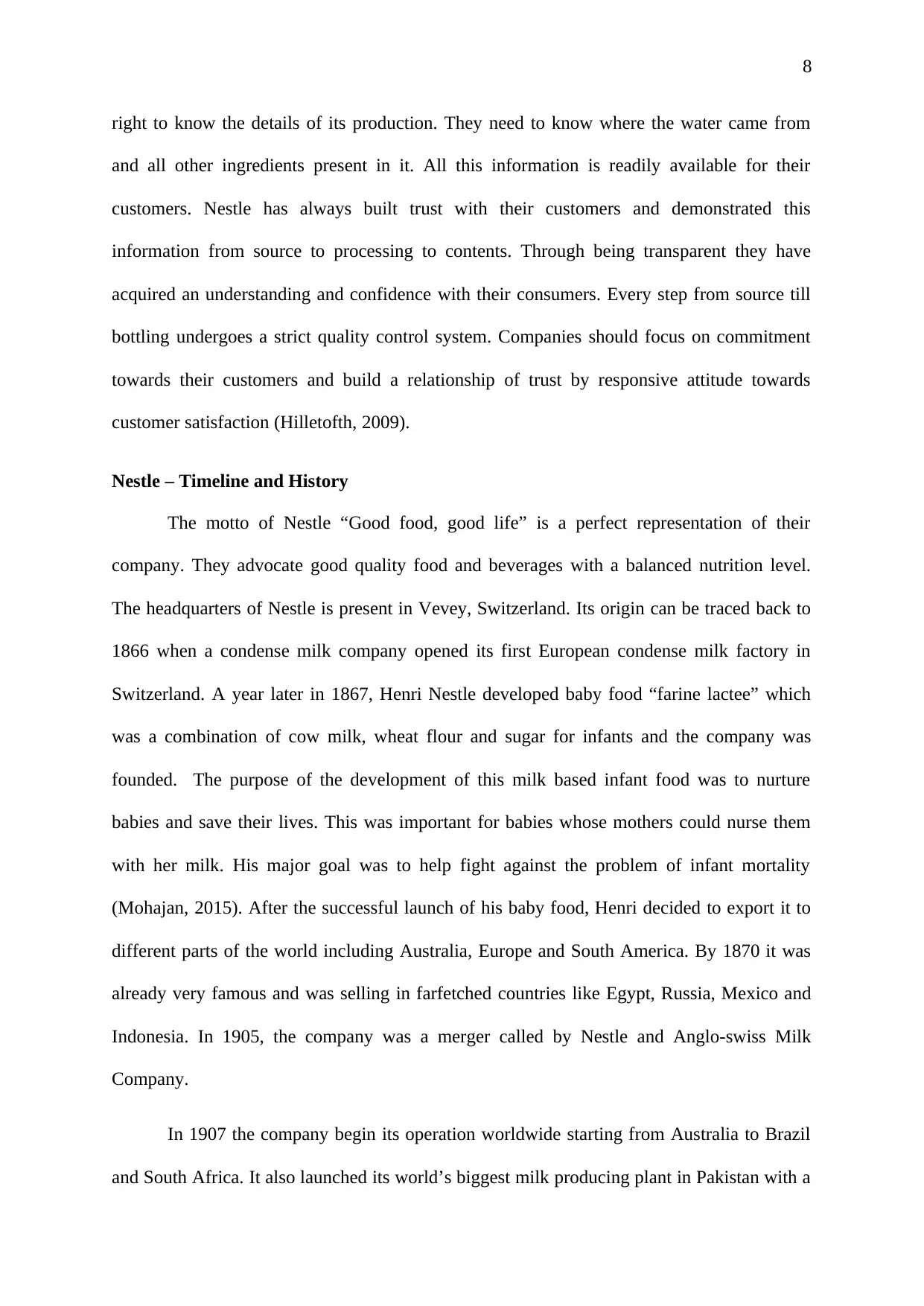
8
right to know the details of its production. They need to know where the water came from
and all other ingredients present in it. All this information is readily available for their
customers. Nestle has always built trust with their customers and demonstrated this
information from source to processing to contents. Through being transparent they have
acquired an understanding and confidence with their consumers. Every step from source till
bottling undergoes a strict quality control system. Companies should focus on commitment
towards their customers and build a relationship of trust by responsive attitude towards
customer satisfaction (Hilletofth, 2009).
Nestle – Timeline and History
The motto of Nestle “Good food, good life” is a perfect representation of their
company. They advocate good quality food and beverages with a balanced nutrition level.
The headquarters of Nestle is present in Vevey, Switzerland. Its origin can be traced back to
1866 when a condense milk company opened its first European condense milk factory in
Switzerland. A year later in 1867, Henri Nestle developed baby food “farine lactee” which
was a combination of cow milk, wheat flour and sugar for infants and the company was
founded. The purpose of the development of this milk based infant food was to nurture
babies and save their lives. This was important for babies whose mothers could nurse them
with her milk. His major goal was to help fight against the problem of infant mortality
(Mohajan, 2015). After the successful launch of his baby food, Henri decided to export it to
different parts of the world including Australia, Europe and South America. By 1870 it was
already very famous and was selling in farfetched countries like Egypt, Russia, Mexico and
Indonesia. In 1905, the company was a merger called by Nestle and Anglo-swiss Milk
Company.
In 1907 the company begin its operation worldwide starting from Australia to Brazil
and South Africa. It also launched its world’s biggest milk producing plant in Pakistan with a
right to know the details of its production. They need to know where the water came from
and all other ingredients present in it. All this information is readily available for their
customers. Nestle has always built trust with their customers and demonstrated this
information from source to processing to contents. Through being transparent they have
acquired an understanding and confidence with their consumers. Every step from source till
bottling undergoes a strict quality control system. Companies should focus on commitment
towards their customers and build a relationship of trust by responsive attitude towards
customer satisfaction (Hilletofth, 2009).
Nestle – Timeline and History
The motto of Nestle “Good food, good life” is a perfect representation of their
company. They advocate good quality food and beverages with a balanced nutrition level.
The headquarters of Nestle is present in Vevey, Switzerland. Its origin can be traced back to
1866 when a condense milk company opened its first European condense milk factory in
Switzerland. A year later in 1867, Henri Nestle developed baby food “farine lactee” which
was a combination of cow milk, wheat flour and sugar for infants and the company was
founded. The purpose of the development of this milk based infant food was to nurture
babies and save their lives. This was important for babies whose mothers could nurse them
with her milk. His major goal was to help fight against the problem of infant mortality
(Mohajan, 2015). After the successful launch of his baby food, Henri decided to export it to
different parts of the world including Australia, Europe and South America. By 1870 it was
already very famous and was selling in farfetched countries like Egypt, Russia, Mexico and
Indonesia. In 1905, the company was a merger called by Nestle and Anglo-swiss Milk
Company.
In 1907 the company begin its operation worldwide starting from Australia to Brazil
and South Africa. It also launched its world’s biggest milk producing plant in Pakistan with a
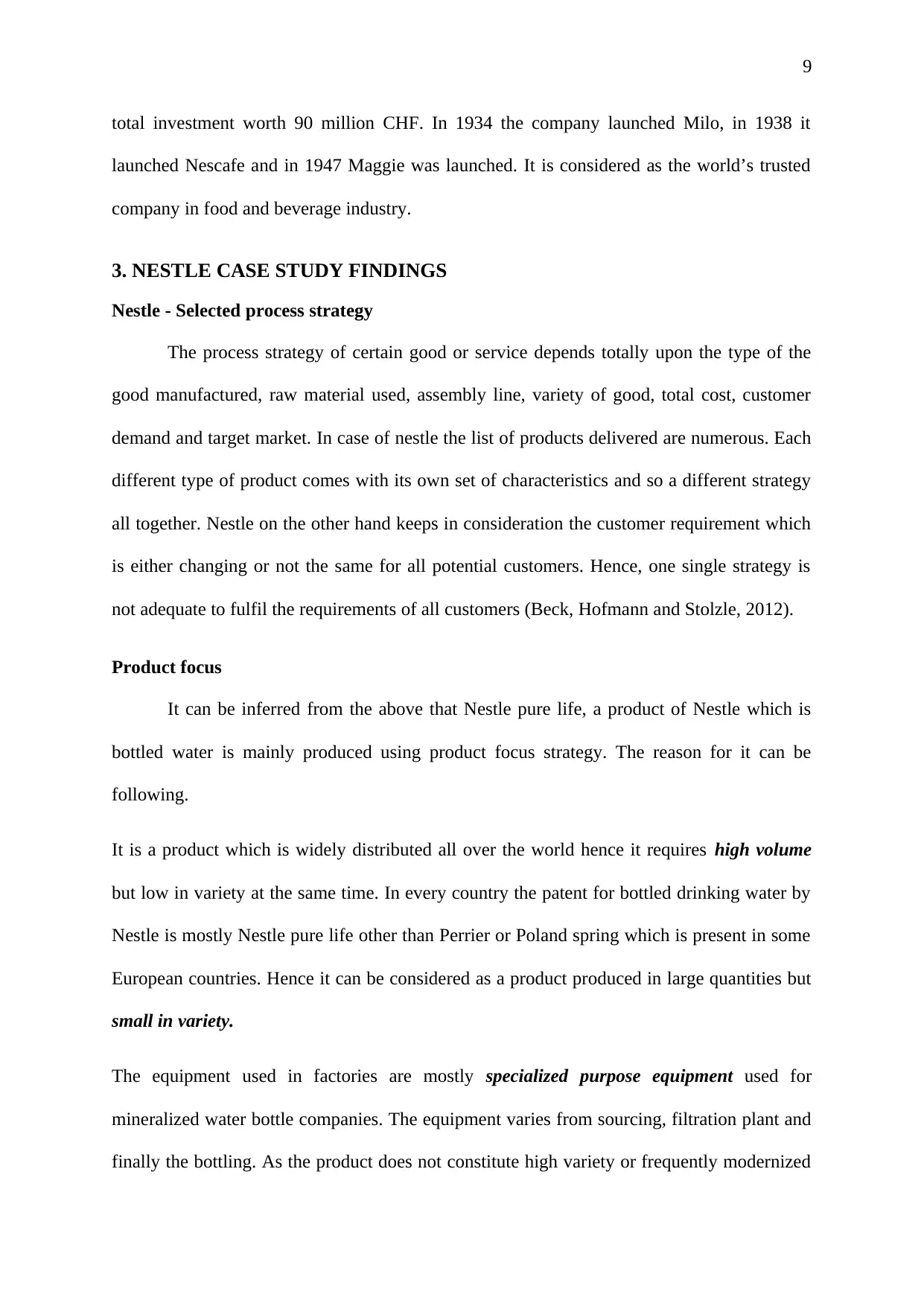
9
total investment worth 90 million CHF. In 1934 the company launched Milo, in 1938 it
launched Nescafe and in 1947 Maggie was launched. It is considered as the world’s trusted
company in food and beverage industry.
3. NESTLE CASE STUDY FINDINGS
Nestle - Selected process strategy
The process strategy of certain good or service depends totally upon the type of the
good manufactured, raw material used, assembly line, variety of good, total cost, customer
demand and target market. In case of nestle the list of products delivered are numerous. Each
different type of product comes with its own set of characteristics and so a different strategy
all together. Nestle on the other hand keeps in consideration the customer requirement which
is either changing or not the same for all potential customers. Hence, one single strategy is
not adequate to fulfil the requirements of all customers (Beck, Hofmann and Stolzle, 2012).
Product focus
It can be inferred from the above that Nestle pure life, a product of Nestle which is
bottled water is mainly produced using product focus strategy. The reason for it can be
following.
It is a product which is widely distributed all over the world hence it requires high volume
but low in variety at the same time. In every country the patent for bottled drinking water by
Nestle is mostly Nestle pure life other than Perrier or Poland spring which is present in some
European countries. Hence it can be considered as a product produced in large quantities but
small in variety.
The equipment used in factories are mostly specialized purpose equipment used for
mineralized water bottle companies. The equipment varies from sourcing, filtration plant and
finally the bottling. As the product does not constitute high variety or frequently modernized
total investment worth 90 million CHF. In 1934 the company launched Milo, in 1938 it
launched Nescafe and in 1947 Maggie was launched. It is considered as the world’s trusted
company in food and beverage industry.
3. NESTLE CASE STUDY FINDINGS
Nestle - Selected process strategy
The process strategy of certain good or service depends totally upon the type of the
good manufactured, raw material used, assembly line, variety of good, total cost, customer
demand and target market. In case of nestle the list of products delivered are numerous. Each
different type of product comes with its own set of characteristics and so a different strategy
all together. Nestle on the other hand keeps in consideration the customer requirement which
is either changing or not the same for all potential customers. Hence, one single strategy is
not adequate to fulfil the requirements of all customers (Beck, Hofmann and Stolzle, 2012).
Product focus
It can be inferred from the above that Nestle pure life, a product of Nestle which is
bottled water is mainly produced using product focus strategy. The reason for it can be
following.
It is a product which is widely distributed all over the world hence it requires high volume
but low in variety at the same time. In every country the patent for bottled drinking water by
Nestle is mostly Nestle pure life other than Perrier or Poland spring which is present in some
European countries. Hence it can be considered as a product produced in large quantities but
small in variety.
The equipment used in factories are mostly specialized purpose equipment used for
mineralized water bottle companies. The equipment varies from sourcing, filtration plant and
finally the bottling. As the product does not constitute high variety or frequently modernized
⊘ This is a preview!⊘
Do you want full access?
Subscribe today to unlock all pages.

Trusted by 1+ million students worldwide
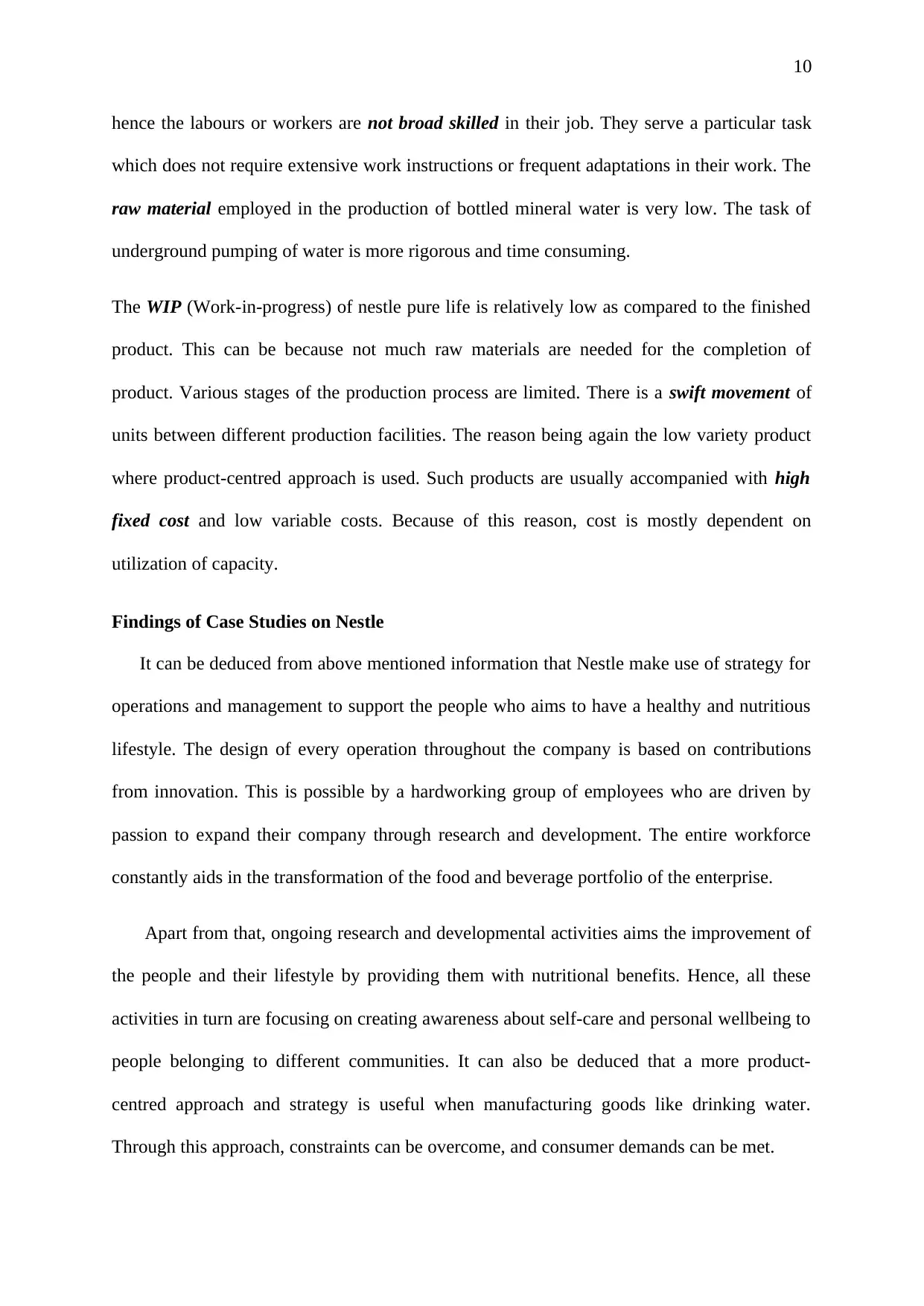
10
hence the labours or workers are not broad skilled in their job. They serve a particular task
which does not require extensive work instructions or frequent adaptations in their work. The
raw material employed in the production of bottled mineral water is very low. The task of
underground pumping of water is more rigorous and time consuming.
The WIP (Work-in-progress) of nestle pure life is relatively low as compared to the finished
product. This can be because not much raw materials are needed for the completion of
product. Various stages of the production process are limited. There is a swift movement of
units between different production facilities. The reason being again the low variety product
where product-centred approach is used. Such products are usually accompanied with high
fixed cost and low variable costs. Because of this reason, cost is mostly dependent on
utilization of capacity.
Findings of Case Studies on Nestle
It can be deduced from above mentioned information that Nestle make use of strategy for
operations and management to support the people who aims to have a healthy and nutritious
lifestyle. The design of every operation throughout the company is based on contributions
from innovation. This is possible by a hardworking group of employees who are driven by
passion to expand their company through research and development. The entire workforce
constantly aids in the transformation of the food and beverage portfolio of the enterprise.
Apart from that, ongoing research and developmental activities aims the improvement of
the people and their lifestyle by providing them with nutritional benefits. Hence, all these
activities in turn are focusing on creating awareness about self-care and personal wellbeing to
people belonging to different communities. It can also be deduced that a more product-
centred approach and strategy is useful when manufacturing goods like drinking water.
Through this approach, constraints can be overcome, and consumer demands can be met.
hence the labours or workers are not broad skilled in their job. They serve a particular task
which does not require extensive work instructions or frequent adaptations in their work. The
raw material employed in the production of bottled mineral water is very low. The task of
underground pumping of water is more rigorous and time consuming.
The WIP (Work-in-progress) of nestle pure life is relatively low as compared to the finished
product. This can be because not much raw materials are needed for the completion of
product. Various stages of the production process are limited. There is a swift movement of
units between different production facilities. The reason being again the low variety product
where product-centred approach is used. Such products are usually accompanied with high
fixed cost and low variable costs. Because of this reason, cost is mostly dependent on
utilization of capacity.
Findings of Case Studies on Nestle
It can be deduced from above mentioned information that Nestle make use of strategy for
operations and management to support the people who aims to have a healthy and nutritious
lifestyle. The design of every operation throughout the company is based on contributions
from innovation. This is possible by a hardworking group of employees who are driven by
passion to expand their company through research and development. The entire workforce
constantly aids in the transformation of the food and beverage portfolio of the enterprise.
Apart from that, ongoing research and developmental activities aims the improvement of
the people and their lifestyle by providing them with nutritional benefits. Hence, all these
activities in turn are focusing on creating awareness about self-care and personal wellbeing to
people belonging to different communities. It can also be deduced that a more product-
centred approach and strategy is useful when manufacturing goods like drinking water.
Through this approach, constraints can be overcome, and consumer demands can be met.
Paraphrase This Document
Need a fresh take? Get an instant paraphrase of this document with our AI Paraphraser
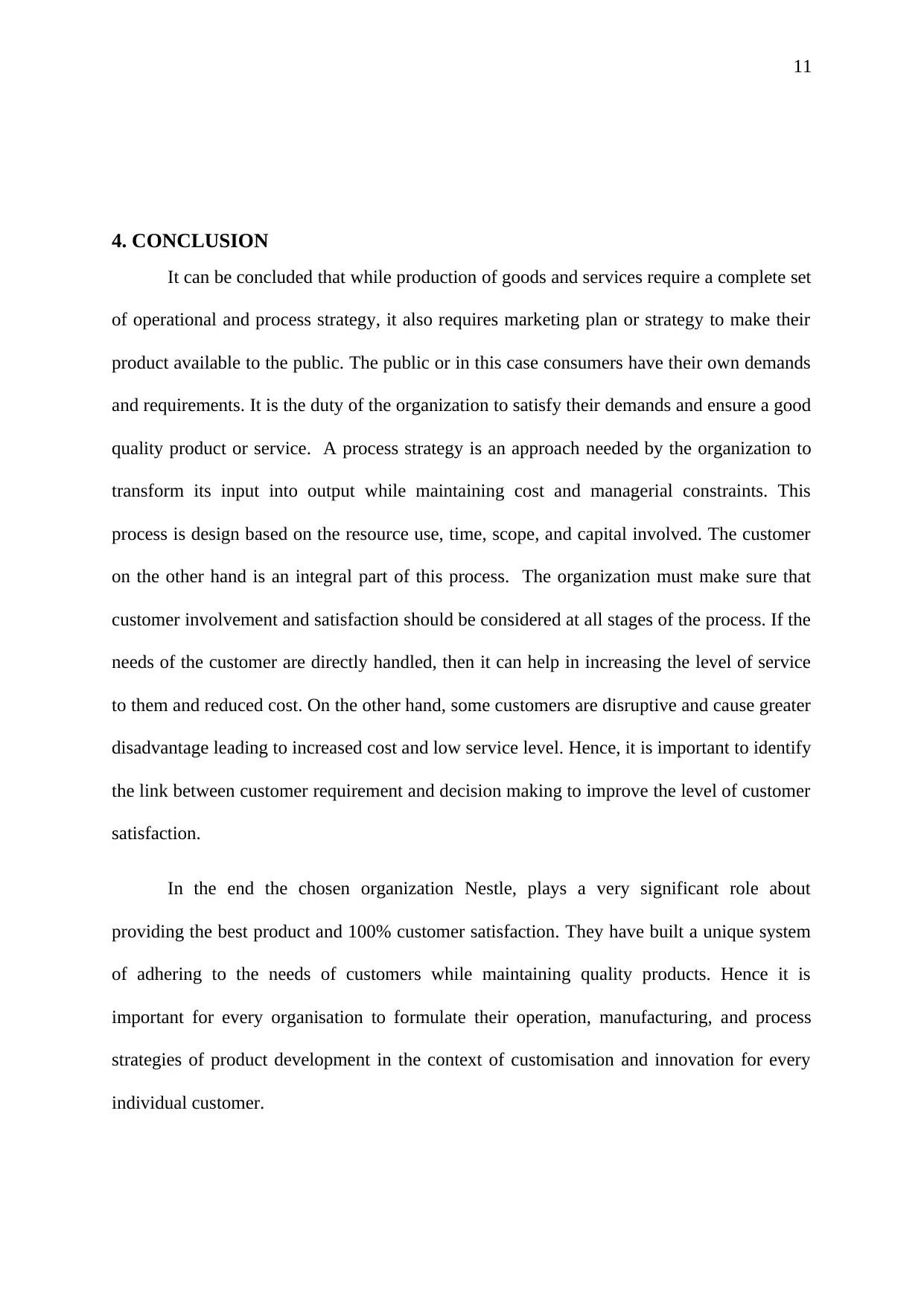
11
4. CONCLUSION
It can be concluded that while production of goods and services require a complete set
of operational and process strategy, it also requires marketing plan or strategy to make their
product available to the public. The public or in this case consumers have their own demands
and requirements. It is the duty of the organization to satisfy their demands and ensure a good
quality product or service. A process strategy is an approach needed by the organization to
transform its input into output while maintaining cost and managerial constraints. This
process is design based on the resource use, time, scope, and capital involved. The customer
on the other hand is an integral part of this process. The organization must make sure that
customer involvement and satisfaction should be considered at all stages of the process. If the
needs of the customer are directly handled, then it can help in increasing the level of service
to them and reduced cost. On the other hand, some customers are disruptive and cause greater
disadvantage leading to increased cost and low service level. Hence, it is important to identify
the link between customer requirement and decision making to improve the level of customer
satisfaction.
In the end the chosen organization Nestle, plays a very significant role about
providing the best product and 100% customer satisfaction. They have built a unique system
of adhering to the needs of customers while maintaining quality products. Hence it is
important for every organisation to formulate their operation, manufacturing, and process
strategies of product development in the context of customisation and innovation for every
individual customer.
4. CONCLUSION
It can be concluded that while production of goods and services require a complete set
of operational and process strategy, it also requires marketing plan or strategy to make their
product available to the public. The public or in this case consumers have their own demands
and requirements. It is the duty of the organization to satisfy their demands and ensure a good
quality product or service. A process strategy is an approach needed by the organization to
transform its input into output while maintaining cost and managerial constraints. This
process is design based on the resource use, time, scope, and capital involved. The customer
on the other hand is an integral part of this process. The organization must make sure that
customer involvement and satisfaction should be considered at all stages of the process. If the
needs of the customer are directly handled, then it can help in increasing the level of service
to them and reduced cost. On the other hand, some customers are disruptive and cause greater
disadvantage leading to increased cost and low service level. Hence, it is important to identify
the link between customer requirement and decision making to improve the level of customer
satisfaction.
In the end the chosen organization Nestle, plays a very significant role about
providing the best product and 100% customer satisfaction. They have built a unique system
of adhering to the needs of customers while maintaining quality products. Hence it is
important for every organisation to formulate their operation, manufacturing, and process
strategies of product development in the context of customisation and innovation for every
individual customer.
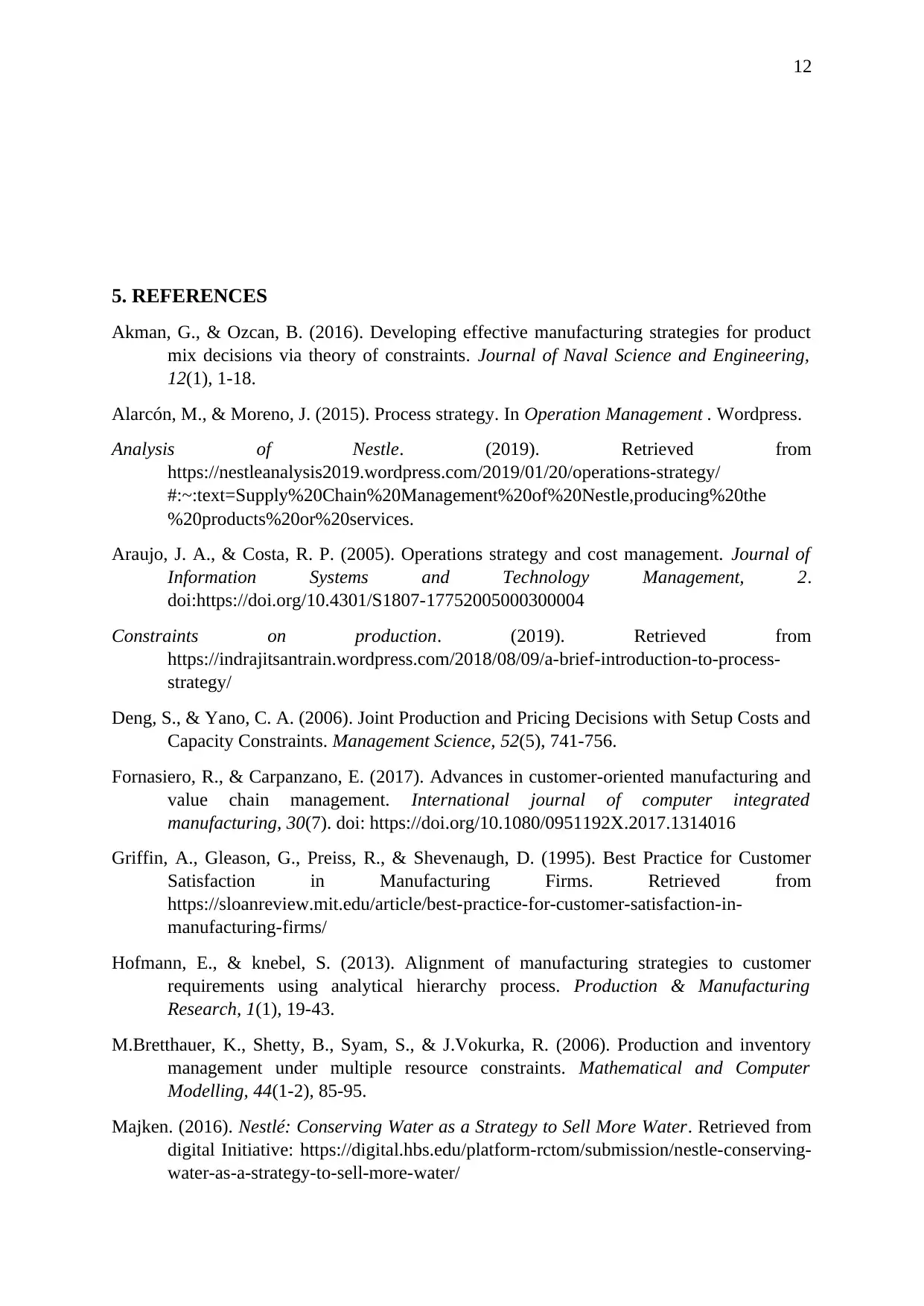
12
5. REFERENCES
Akman, G., & Ozcan, B. (2016). Developing effective manufacturing strategies for product
mix decisions via theory of constraints. Journal of Naval Science and Engineering,
12(1), 1-18.
Alarcón, M., & Moreno, J. (2015). Process strategy. In Operation Management . Wordpress.
Analysis of Nestle. (2019). Retrieved from
https://nestleanalysis2019.wordpress.com/2019/01/20/operations-strategy/
#:~:text=Supply%20Chain%20Management%20of%20Nestle,producing%20the
%20products%20or%20services.
Araujo, J. A., & Costa, R. P. (2005). Operations strategy and cost management. Journal of
Information Systems and Technology Management, 2.
doi:https://doi.org/10.4301/S1807-17752005000300004
Constraints on production. (2019). Retrieved from
https://indrajitsantrain.wordpress.com/2018/08/09/a-brief-introduction-to-process-
strategy/
Deng, S., & Yano, C. A. (2006). Joint Production and Pricing Decisions with Setup Costs and
Capacity Constraints. Management Science, 52(5), 741-756.
Fornasiero, R., & Carpanzano, E. (2017). Advances in customer-oriented manufacturing and
value chain management. International journal of computer integrated
manufacturing, 30(7). doi: https://doi.org/10.1080/0951192X.2017.1314016
Griffin, A., Gleason, G., Preiss, R., & Shevenaugh, D. (1995). Best Practice for Customer
Satisfaction in Manufacturing Firms. Retrieved from
https://sloanreview.mit.edu/article/best-practice-for-customer-satisfaction-in-
manufacturing-firms/
Hofmann, E., & knebel, S. (2013). Alignment of manufacturing strategies to customer
requirements using analytical hierarchy process. Production & Manufacturing
Research, 1(1), 19-43.
M.Bretthauer, K., Shetty, B., Syam, S., & J.Vokurka, R. (2006). Production and inventory
management under multiple resource constraints. Mathematical and Computer
Modelling, 44(1-2), 85-95.
Majken. (2016). Nestlé: Conserving Water as a Strategy to Sell More Water. Retrieved from
digital Initiative: https://digital.hbs.edu/platform-rctom/submission/nestle-conserving-
water-as-a-strategy-to-sell-more-water/
5. REFERENCES
Akman, G., & Ozcan, B. (2016). Developing effective manufacturing strategies for product
mix decisions via theory of constraints. Journal of Naval Science and Engineering,
12(1), 1-18.
Alarcón, M., & Moreno, J. (2015). Process strategy. In Operation Management . Wordpress.
Analysis of Nestle. (2019). Retrieved from
https://nestleanalysis2019.wordpress.com/2019/01/20/operations-strategy/
#:~:text=Supply%20Chain%20Management%20of%20Nestle,producing%20the
%20products%20or%20services.
Araujo, J. A., & Costa, R. P. (2005). Operations strategy and cost management. Journal of
Information Systems and Technology Management, 2.
doi:https://doi.org/10.4301/S1807-17752005000300004
Constraints on production. (2019). Retrieved from
https://indrajitsantrain.wordpress.com/2018/08/09/a-brief-introduction-to-process-
strategy/
Deng, S., & Yano, C. A. (2006). Joint Production and Pricing Decisions with Setup Costs and
Capacity Constraints. Management Science, 52(5), 741-756.
Fornasiero, R., & Carpanzano, E. (2017). Advances in customer-oriented manufacturing and
value chain management. International journal of computer integrated
manufacturing, 30(7). doi: https://doi.org/10.1080/0951192X.2017.1314016
Griffin, A., Gleason, G., Preiss, R., & Shevenaugh, D. (1995). Best Practice for Customer
Satisfaction in Manufacturing Firms. Retrieved from
https://sloanreview.mit.edu/article/best-practice-for-customer-satisfaction-in-
manufacturing-firms/
Hofmann, E., & knebel, S. (2013). Alignment of manufacturing strategies to customer
requirements using analytical hierarchy process. Production & Manufacturing
Research, 1(1), 19-43.
M.Bretthauer, K., Shetty, B., Syam, S., & J.Vokurka, R. (2006). Production and inventory
management under multiple resource constraints. Mathematical and Computer
Modelling, 44(1-2), 85-95.
Majken. (2016). Nestlé: Conserving Water as a Strategy to Sell More Water. Retrieved from
digital Initiative: https://digital.hbs.edu/platform-rctom/submission/nestle-conserving-
water-as-a-strategy-to-sell-more-water/
⊘ This is a preview!⊘
Do you want full access?
Subscribe today to unlock all pages.

Trusted by 1+ million students worldwide
1 out of 13
Related Documents
Your All-in-One AI-Powered Toolkit for Academic Success.
+13062052269
info@desklib.com
Available 24*7 on WhatsApp / Email
![[object Object]](/_next/static/media/star-bottom.7253800d.svg)
Unlock your academic potential
Copyright © 2020–2025 A2Z Services. All Rights Reserved. Developed and managed by ZUCOL.




